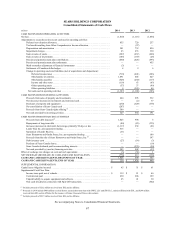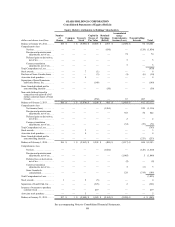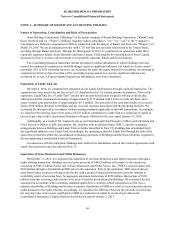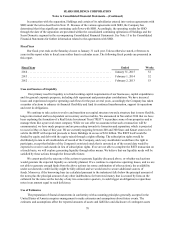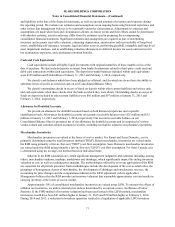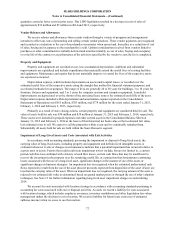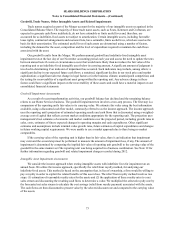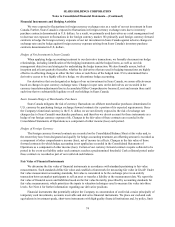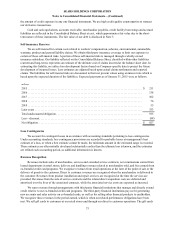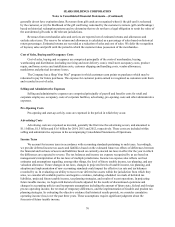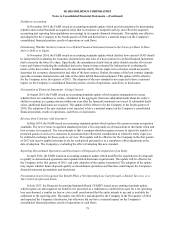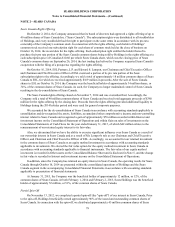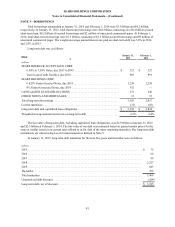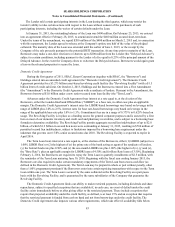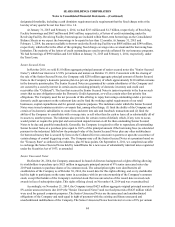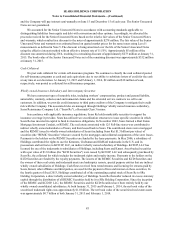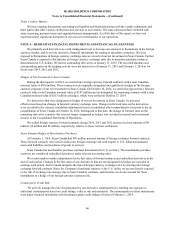Sears 2014 Annual Report Download - page 77
Download and view the complete annual report
Please find page 77 of the 2014 Sears annual report below. You can navigate through the pages in the report by either clicking on the pages listed below, or by using the keyword search tool below to find specific information within the annual report.SEARS HOLDINGS CORPORATION
Notes to Consolidated Financial Statements—(Continued)
77
Income tax expense or benefit from continuing operations is generally determined without regard to other
categories of earnings, such as discontinued operations and other comprehensive income ("OCI"). An exception is
provided in the authoritative accounting guidance when there is income from categories other than continuing
operations and a loss from continuing operations in the current year. In this case, the tax benefit allocated to
continuing operations is the amount by which the loss from continuing operations reduces the tax expense recorded
with respect to the other categories of earnings, even when a valuation allowance has been established against the
deferred tax assets. In instances where a valuation allowance is established against current year losses, income from
other sources, including gain from pension and other postretirement benefits recorded as a component of OCI or the
creation of a deferred tax liability through additional paid-in capital for the book to tax difference for the original
issue discount relating to the $625 million 8% senior unsecured notes due 2019, is considered when determining
whether sufficient future taxable income exists to realize the deferred tax assets.
Stock-based Compensation
We account for stock-based compensation arrangements in accordance with accounting standards pertaining to
share-based payment transactions, which requires us to both recognize as expense the fair value of all stock-based
compensation awards (which includes stock options, although there were no options outstanding in 2014) and to
classify excess tax benefits associated with share-based compensation deductions as cash from financing activities
rather than cash from operating activities. We recognize compensation expense as awards vest on a straight-line
basis over the requisite service period of the award.
Earnings Per Common Share
Basic earnings per common share is calculated by dividing net income attributable to Holdings' shareholders
by the weighted average number of common shares outstanding for each period. Diluted earnings per common share
also includes the dilutive effect of potential common shares, exercise of stock options, warrants and the effect of
restricted stock when dilutive.
New Accounting Pronouncements
Consolidation
In February 2015, the Financial Accounting Standards Board ("FASB") issued an accounting standards update
which revises the consolidation model. Specifically, the amendments modify the evaluation of whether limited
partnerships and similar legal entities are variable interest entities (VIEs) or voting interest entities, eliminate the
presumption that a general partner should consolidate a limited partnership, affect the consolidation analysis of
reporting entities that are involved with VIEs, particularly those that have fee arrangements and related party
relationships, and provide a scope exception from consolidation guidance for reporting entities with interests in legal
entities that are required to comply with or operate in accordance with requirements that are similar to those in Rule
2a-7 of the Investment Company Act of 1940 for registered money market funds. This update will be effective for
the Company in the first quarter of 2015. The adoption of the new standard is not expected to have a material impact
on the Company’s consolidated financial position, results of operations, cash flows or disclosures.
Extraordinary and Unusual Items
In January 2015, the FASB issued an accounting standards update which eliminates the concept of an
extraordinary item. Extraordinary items are events and transactions that are distinguished by their unusual nature
and by the infrequency of their occurrence. Eliminating the extraordinary classification simplifies income statement
presentation by altogether removing the concept of extraordinary items from consideration. This update will be
effective for the Company in the first quarter of 2015. The adoption of the new standard is not expected to have a
material impact on the Company’s consolidated financial position, results of operations, cash flows or disclosures.


